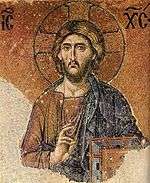Chuvash people
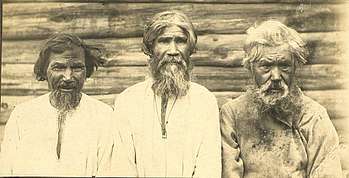 Group of aged Chuvash men, early 20th century. | |
| Total population | |
|---|---|
| c. 1.5 million | |
| Regions with significant populations | |
| 1,435,872[1][2] | |
| 22,305[3] | |
| 10,593[4] | |
| 10,074[5] | |
| 2,281[6] | |
| 2,242[7] | |
| 1,204[8] | |
| 900 | |
| 848[9] | |
| 542[10] | |
| 489[11] | |
| 373[12] | |
| Languages | |
|
Chuvash Russian | |
| Religion | |
| Russian Orthodox Christianity | |
| Related ethnic groups | |
| Volga Tatars, Mari people | |

.png)
The Chuvash people (/tʃʊˈvɑːʃ/; Chuvash: чăваш, IPA: [t͡ɕəˈʋaʂ]; Russian: чуваши, pronounced [t͡ɕʊˈvaʂɨ]) are a Turkic ethnic group, native to an area stretching from the Volga Region to Siberia. Most of them live in the Republic of Chuvashia and surrounding areas, although Chuvash communities may be found throughout the Russian Federation.
Etymology
There is no universally accepted etymology of the word Chuvash, but there are two main theories that try to explain it: one suggests that the word Chuvash may be derived from Common Turkic jăvaš (‘friendly’, ‘peaceful’), as opposed to şarmăs (‘warlike’). Another theory is based on the Tabghach, an early medieval Xianbei clan and founders of the Northern Wei dynasty in China. The Old Turkic name Tabghach (Tuoba in Mandarin) was used by some Inner Asian peoples to refer to China long after this dynasty. Gerard Clauson has shown that through regular sound changes, the clan name Tabghach may have transformed to the ethnonym Chuvash.[13]
Origin
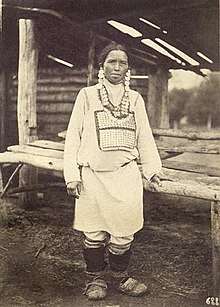
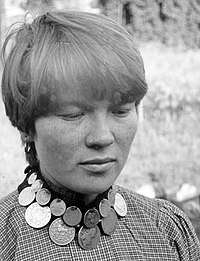
There are rival schools of thought on the origin of the Chuvash people. One is that they originated from a mixing between the Turkic Sabir tribes of Volga Bulgaria and also according to some researches with local Finno-Ugric populations.[14]
According to another theory, the Chuvash may be descended from the Volga Bulgars.[15]
They have been subjected to much infusion and influence, not only from Russian and Turkic peoples, but also from neighboring Finnic tribes, with whom they were persistently and mistakenly identified for centuries, perhaps aided by the fact that the Chuvash language is a highly divergent form of Turkic, and was not easily recognized as such.[15] Chuvash is classified, alongside the extinct Bulgar language, as the only remaining member of the Oghuric branch of the Turkic language family.
Genetics
Physical anthropologists using the racial frameworks of the early 20th Century saw the Chuvash as a mixed Finno-Ugric and Turkic people.[16][15]
In surveys of mitochondrial DNA (mtDNA), haplogroups J2 (mostly J2a) and E are most common among the Chuvash, followed by N and R1a.[17]
Subclades of Y-DNA haplogroups R1 and N are most common among the Chuvash. According to Rootsi et al. 2004, Tambets et al. 2004 (79 samples), and Trofimova 2005 (43 samples) the following distribution of haplogroups is obtained:[18]
- I1: 7%
- I2a2: 0–2%
- I2a1: 0–2%
- J1: 0–2%
- J2a: 0–9%
- J2b: 0–5%
- Q: 0%
- R1b: 2–4%
- R1a: 28–32%
- N1c1: 18–19%
- N1c2: 9–10%
- E-M78: 0–14%
- C: 0–1%
Haplogroups Q and C are rare among Chuvashes. Chuvash carriers of Haplogroup R1a (19% in hundreds of samples) are Balto-Slavic Z282 subclade.[19]
A study sampling of unrelated 96 Chuvashes concluded:
Earlier genetic research using autosomal DNA markers suggested a Finno-Ugric origin for the Chuvash. This study examines non-recombining DNA markers to better elucidate their origins. The majority of individuals in this sample exhibit haplogroups H (31%), U (22%), and K (11%), all representative of western and northern Europeans, but absent in Altaic or Mongolian populations. Multidimensional scaling (MDS) was used to examine distances between the Chuvash and 8 reference populations compiled from the literature. Mismatch analysis showed a unimodal distribution. Along with neutrality tests (Tajima's D (−1.43365) p < 0.05, Fu's FS (−25.50518) p < 0.001), the mismatch distribution is suggestive of an expanding population. These tests suggest that the Chuvash are not related to the Altai and Mongolia along their maternal line but supports the hypothesis that their language was imposed by a conquering group—leaving Chuvash mtDNA largely of Eurasian origin with a small amount of Central Asian gene flow. Their maternal markers appear to most closely resemble Finno-Ugric speakers rather than fellow Turkic speakers.
Later, the assertion H, U, and K are "absent in Altaic or Mongolian populations" turned into "virtually absent in Altaic or Mongolian populations."[20] The MtDNA gene pool was found to be 89.1% Caucasoid, 9.1% East Asian and 1.8% unidentified.[21]
According to autosomal analyses: "Present-day Chuvash speak an Altaic-Turkic language and are genetically related to Caucasians (Georgians), Mediterraneans, and Middle Easterners, and not only to Central or Northern Europeans; Chuvash contain little indications of Central Asian-Altaic gene flow. Thus, present-day Chuvash who speak an Altaic-Turkic language are probably more closely related to ancient Mesopotamian-Hittites and northern European populations than to central Asia-Altaic people."[22]
Finally, an autosomal analysis detected an indication of Oghur and possibly Bulgar ancestry, from which the Chuvashes developed their language: "Chuvashes, the only extant Oghur speakers showed an older admixture date (9th century) than their Kipchak-speaking neighbors in the Volga region. According to historical sources, when the Onogur-Bolgar Empire (northern Black Sea steppes) fell apart in the 7th century, some of its remnants migrated northward along the right bank of the Volga river and established what later came to be known as Volga Bolgars, of which the first written knowledge appears in Muslim sources only around the end of the 9th century. Thus, the admixture signal for Chuvashes is close to the supposed arrival time of Oghur speakers in the Volga region."[23]
Another study admitted substantial Finno-Ugric component in Chuvashes, unlike its complete absence in Bashkirs, but noted that some aspects of HLA in Tatars are close to Chuvashes and Bulgarians, declaring the suggestion of Bulgar descent.[24]
According to other study of HLA the Bulgar descent of the Chuvash can not be confirmed and that Bulgarians and Chuvashes are clearly different:[25]
Bulgars left for the Balkans, while another subdivision moved to the mid-Volga region and made up the ethnic base of the Chuvash and Kazan Tatars. ... The Chuvash have a central European and some Mediterranean genetic background (probably coming from the Caucasus).... Chuvash and the fifth representing present day Bulgarians. From the data obtained in the present work, the genetic backgrounds of both populations are clearly different. ... It is possible that only a cultural and low genetic Bulgar influence was brought into the region without modifying the genetic background of the local population...The Chuvash relatedness to Caucasian (Georgians) and Middle Eastern people suggests that the Chuvash genetic pool has characteristics from ancient Middle Eastern, Caucasian, and Mesopotamian people. ... On the other hand, whether the Chuvash are a remnant of the Bulgar Hordes cannot be resolved with the data presented in this paper, and further studies are necessary.
Subgroups
Chuvash people are divided into two main groups:
History

The Turkic ancestors of the Chuvash people are believed to have come from central Siberia, where they lived in the Irtysh basin (between the Tian Shan and Altay) from at least the end of the third millennium BC. In the beginning of the first century AD, the Bulgars started moving west through Zhetysu and the steppes of modern-day Kazakhstan, reaching the North Caucasus in 2nd–3rd centuries AD. There they established several states (Old Bulgaria on the Black Sea coast and the Suar Duchy in modern-day Dagestan.
Old Bulgaria broke up in the second half of the 7th century after a series of successful Khazar invasions. Some of its population fled north, to the Volga-Kama region, where they established Volga Bulgaria, which eventually became extremely wealthy: its capital being the 4th largest city in the world. Shortly after that, the Suvar Duchy was forced to become a vassal state of Khazaria. About half a century later, the Suvars took part in the Arab–Khazar wars of 732–737.
It is believed that the Chuvash people came in strong contact with Iranian tribes.[26]
Culture
They speak the Chuvash language and have some pre-Christian traditions. In addition to Chuvash,[27] many people also use the Russian language.
Religion
Today Chuvash people are Eastern Orthodox Christians and belong to the Russian Orthodox Church. They retain some pre-Christian (or pagan) traditions in their cultural activities.
Gallery
 Atner Huzangaj.
Atner Huzangaj. Chuvash dancer.
Chuvash dancer. Portrait of Chuvashes during a festival.
Portrait of Chuvashes during a festival. Chuvashes at the court with traditional dress.
Chuvashes at the court with traditional dress.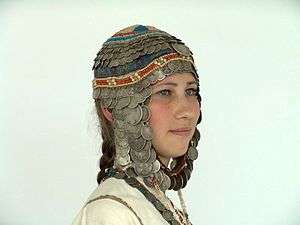 A Chuvash woman in traditional dress.
A Chuvash woman in traditional dress.
See also
| Wikimedia Commons has media related to Chuvash people. |
References
- ↑ Census 2010
- ↑ Census 2002
- ↑ "Демоскоп Weekly - Приложение. Справочник статистических показателей". Demoscope.ru. 2013-03-21. Archived from the original on 2011-06-04. Retrieved 2016-02-09.
- ↑ "Всеукраїнський перепис населення 2001 - English version - Results - Nationality and citizenship - The distribution of the population by nationality and mother tongue - Selection:". 2001.ukrcensus.gov.ua.
- ↑
- ↑ "Демоскоп Weekly - Приложение. Справочник статистических показателей". Demoscope.ru. 2013-03-21. Archived from the original on 2012-03-14. Retrieved 2016-02-09.
- ↑ "НАЦИОНАЛЬНЫЙ СОСТАВ НАСЕЛЕНИЯ РЕСПУБЛИКИ БЕЛАРУСЬ (ETHNIC COMPOSITION OF POPULATION OF THE REPUBLIC OF BELARUS)". Archived from the original on February 7, 2009. Retrieved October 21, 2009.
- ↑ "Демоскоп Weekly - Приложение. Справочник статистических показателей". Demoscope.ru. 2013-03-21. Archived from the original on 2016-01-25. Retrieved 2016-02-09.
- ↑ "Демографические тенденции, формирование наций и межэтнические отношения в Киргизии". Demoscope.ru. Archived from the original on 2016-02-06. Retrieved 2016-02-09.
- ↑ "Демоскоп Weekly - Приложение. Справочник статистических показателей". Demoscope.ru. 2013-03-21. Retrieved 2016-02-09.
- ↑ "Демоскоп Weekly - Приложение. Справочник статистических показателей". Demoscope.ru. 2013-03-21. Archived from the original on 2011-08-26. Retrieved 2016-02-09.
- ↑ "RAHVASTIK RAHVUSE, SOO JA ELUKOHA JÄRGI, 31. DETSEMBER 2011". pub.stat.ee.
- ↑ Gerard Clauson, Studies in Turkic and Mongolic Linguistics. Routledge, 2002, p. 23.
- ↑ Orion M. Graf, John Mitchell, Stephen Wilcox, Gregory Livshits, and Michael H. Crawford. Chuvash origins: Evidence from mtDNA Markers. (2010) "Their maternal markers appear to most closely resemble Finno-Ugric speakers rather than fellow Turkic speakers."
- 1 2 3 John R. Krueger, Chuvash Manual. Introduction, Grammar, Reader, and Vocabulary (Hague, 1961), 7–8.
- ↑

- ↑ "Family Tree DNA – Chuvashia DNA Project". familytreedna.com.
- ↑ "Family Tree DNA - Genetic Testing for Ancestry, Family History & Genealogy". www.familytreedna.com.
- ↑ "European Journal of Human Genetics – Supplementary Information for article: The phylogenetic and geographic structure of Y-chromosome haplogroup R1a". Naturecom. 23.
- ↑ Orion M. Graf, Stephen M. Johnson, John Mitchell, Stephen Wilcox, Gregory Livshits, and Michael H. Crawford. "Analysis of Chuvash mtDNA points to Finno-Ugric origin"
- ↑ S. A. Fedorova; M. A. Bermisheva; R. Villems; N. R. Maksimova; E. K. Khusnutdinova. "Analysis of Mitochondrial DNA Lineages in Yakuts" (PDF). Evolutsioon.ut.ee. Retrieved 9 January 2018.
- ↑ Arnaiz-Villena, Antonio; Martinez-Laso, Jorge; Moscoso, Juan; Livshits, Gregory; Zamora, Jorge; Gomez-Casado, Eduardo; Silvera-Redondo, Carlos; Melvin, Kristin; Crawford, Michael H. (1 June 2003). "HLA genes in the Chuvashian population from European Russia: admixture of Central European and Mediterranean populations". Human Biology. 75 (3): 375–392. doi:10.1353/hub.2003.0040. ISSN 0018-7143. PMID 14527201.
- ↑ Yunusbayev, Bayazit; Metspalu, Mait; Metspalu, Ene; Valeev, Albert; Litvinov, Sergei; Valiev, Ruslan; Akhmetova, Vita; Balanovska, Elena; Balanovsky, Oleg; Turdikulova, Shahlo; Dalimova, Dilbar; Nymadawa, Pagbajabyn; Bahmanimehr, Ardeshir; Sahakyan, Hovhannes; Tambets, Kristiina; Fedorova, Sardana; Barashkov, Nikolay; Khidiyatova, Irina; Mihailov, Evelin; Khusainova, Rita; Damba, Larisa; Derenko, Miroslava; Malyarchuk, Boris; Osipova, Ludmila; Voevoda, Mikhail; Yepiskoposyan, Levon; Kivisild, Toomas; Khusnutdinova, Elza; Villems, Richard (21 April 2015). "The Genetic Legacy of the Expansion of Turkic-Speaking Nomads across Eurasia". PLOS Genet. 11 (4): e1005068. doi:10.1371/journal.pgen.1005068. ISSN 1553-7404.
- ↑ Suslova, T. A.; Burmistrova, A. L.; Chernova, M. S.; Khromova, E. B.; Lupar, E. I.; Timofeeva, S. V.; Devald, I. V.; Vavilov, M. N.; Darke, C. (1 October 2012). "HLA gene and haplotype frequencies in Russians, Bashkirs and Tatars, living in the Chelyabinsk Region (Russian South Urals)". International Journal of Immunogenetics. 39 (5): 394–408. doi:10.1111/j.1744-313X.2012.01117.x. ISSN 1744-313X. PMID 22520580.
- ↑ Arnaiz-Villena, Antonio; Martinez-Laso, Jorge; Moscoso, Juan; Livshits, Gregory; Zamora, Jorge; Gomez-Casado, Eduardo; Silvera-Redondo, Carlos; Melvin, Kristin; Crawford, Michael H. (1 June 2003). "HLA Genes in the Chuvashian Population from European Russia: Admixture of Central European and Mediterranean Populations" (PDF). Human Biology. 75 (3): 375–392. doi:10.1353/hub.2003.0040. ISSN 1534-6617. PMID 14527201.
- ↑ "The Iranian Chapter in the History of the Chuvash". Archaeology, Ethnology and Anthropology of Eurasia. 41 (3): 112–119. 2013-09-01. doi:10.1016/j.aeae.2014.03.014. ISSN 1563-0110.
- ↑ ""Haval" somera tendaro 2015 | Чувашская общественная организация "Хавал"". Cv-haval.org (in Russian). Retrieved 2016-02-09.
